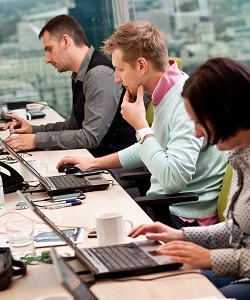
Common Hazards in the Office
When speaking of workplace safety, people are usually referring to factories, mines, and other industrial settings.
These places often expose workers to dangerous conditions, like temperature extremes, the risk of cave-ins and exposure to dangerous materials.
The asbestos industry has plenty of examples of dangerous jobs in high risk areas.
However, workplace safety doesn’t just apply to people who work in factories and other industrial settings. While those jobs certainly have their fair share of risk, even your basic desk job can have risks as well.
These risks go beyond threats to your waistline, from too much sitting and too many office donuts to actual risks to your health and safety.
In fact, there are four common hazards that can occur in any office environment and can put workers at risk.
Poor Air Quality
Poor air quality could be the result of a faulty or poorly maintained HVAC system, inadequate ventilation, overcrowding and poor housekeeping.
Poor air quality can also be caused by particles of asbestos being released into the air when asbestos-containing materials become damaged. This last factor is most likely to occur in older buildings, especially if parts of the building are under construction or being remodeled.
Poor air quality can contribute to allergies and other respiratory disorders. It can also make it easier for airborne diseases, like the flu, to spread around the office. In fact, poor air quality in offices is such an issue that there’s even a name for it: Sick Building Syndrome.
Properly maintaining and cleaning the HVAC system can solve many of the respiratory problems; so can making people spread out so that they aren’t right on top of each other.
Keeping restrooms and break areas clean will cut down on the spread of germs from those areas, as can keeping the main office area clean – this can be done by a regular janitorial staff, but workers can also do their part by cleaning up after themselves.
When remodeling or rebuilding areas of old buildings, management should have the area tested for asbestos and hire an experienced company to remove it. Workers should be moved to another area during the removal process.
Slips and Falls
Slipping, tripping and falling are actually quite common in office settings and can be caused by a variety of factors including wet floors, poorly maintained electrical cords, uneven and loose flooring and clutter in the walkways.
Slips and falls can also occur outside the office, especially in inclement weather when you are more likely to encounter hazards like snow and ice.
Slip and fall injuries can range from minor to severe, including sprains, strains, concussions and even broken bones. Some people have actually died from seemingly innocent falls.
The best way to prevent slip and fall injuries is to make sure all the walkways are free of clutter and that wet floors are clearly marked and excess water is removed immediately. Loose or damaged flooring should also be clearly marked and replaced or repaired as quickly as possible.
Outside of the office, parking lots and walkways should be cleared of snow, ice and any other hazards. Placing non-slip mats at entrance ways can prevent people from tracking water, ice and snow into the building and from slipping as they enter.
Ergonomic Injuries and Eye Strain
Ergonomic injuries are caused by poor posture and poor work practices. Eye strain is a subset of ergonomic injuries. The most common causes are:
- Having your workstation out of alignment with your body, such as the monitor placed too low
- Sitting in a slouched position, or sitting in a position that causes you to tense your arms and shoulders
- Having your feet in the wrong position
- Inadequate workstation lighting
- Staring at a monitor for too long
The best way to prevent ergonomic injuries is to position the elements in your workstation so that they are in alignment with your body. This means adjusting the chair height so that your knees are bent 90 degrees and your elbows are bent 90 degrees while typing.
It also means keeping your monitor at eye level, and ensuring that it’s bright enough that you can read it without straining, but not so bright that it hurts your eyes. You should also take frequent breaks to rest your eyes, and walk around to loosen the muscles in your back, neck, and shoulders.
As you can see, even the nicest office can have its fair share of hazards. Fortunately, offices are still not as dangerous as industrial settings, and there are simple ways to avoid some of the worst hazards.